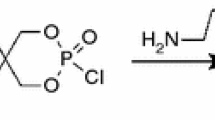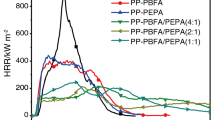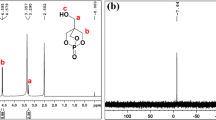Abstract
A phosphorous–nitrogen containing cyclophosphazene derivative intumescent flame retardant with branched structures, named six(1-oxo-2,6,7-trioxa-1-phosphabicyclo[2,2,2]octane-4-methyl) cyclotriphosphazene (PEPAP), was synthesized by introducing caged phosphate to cyclotriphosphazene backbone. Then the PEPAP was applied to polypropylene (PP) by melt blending to improve the flame retardancy and thermal stability. Fourier transform infrared spectroscopy and proton nuclear magnetic resonance (1HNMR) were used to confirm the chemical structure of PEPAP. Thermal stability and flammability properties of PEPAP and PEPAP/PP composites were investigated by thermogravimetric analysis, limited oxygen index (LOI), vertical burning test (UL-94) and cone calorimetry tests. The flame-retardant mechanism was explored by thermogravimetric analysis/infrared spectrometry and thermogravimetry/mass spectrum analysis. The results showed that PEPAP had high thermal stability, and the addition of PEPAP greatly enhanced the carbonization process of PP. Also, the addition of PEPAP can dramatically improve the LOI value and UL 94 rating. For the 25% PEPAP/PP sample, the LOI value was increased to 29.4% and it can pass UL 94 V-0. The intumescent chars with an intact, multicellular structure formed from PEPAP/PP composites contain polyphosphoric acid, indicating a condensed flame-retardant mechanism of PEPAP.













Similar content being viewed by others
References
Wen P, Wang D, Liu J, Zhan J, Hu Y, Yuen RKK. Organically modified montmorillonite as a synergist for intumescent flame retardant against the flammable polypropylene. Polym Adv Technol. 2017;28(6):679–85.
Kong Q, Zhang H, Zheng L, Wang D-Y, Zhang J. Effect on thermal and combustion behaviors of montmorillonite intercalation nickel compounds in polypropylene/IFR system. Polym Adv Technol. 2017;28(8):965–70.
Zheng Z, Liu Y, Zhang L, Wang H. Synergistic effect of expandable graphite and intumescent flame retardants on the flame retardancy and thermal stability of polypropylene. J Mater Sci. 2016;51(12):5857–71.
Li X, Zhao Z, Wang Y, Yan H, Zhang X, Xu B. Highly efficient flame retardant, flexible, and strong adhesive intumescent coating on polypropylene using hyperbranched polyamide. Chem Eng J. 2017;324:237–50.
Palacios E, Leret P, De La Mata MJ, Fernández JF, De Aza AH, Rodríguez MA, Rubio-Marcos F. Self-forming 3D core–shell ceramic nanostructures for halogen-free flame retardant materials. ACS Appl Mat Interfaces. 2016;8(14):9462–71.
Birnbaum LS, Staskal DF. Brominated flame retardants: cause for concern? Environ Health Perspect. 2003;112(1):9–17.
Nie S, Liu L, Dai G, Zhou C. Investigation on pyrolysis of intumescent flame-retardant polypropylene (PP) composites based on synchrotron vacuum ultraviolet photoionization combined with molecular-beam mass spectrometry. J Therm Anal Calorim. 2017;130(2):1003–9.
Wang X, Li Y, Liao W, Gu J, Li D. A new intumescent flame-retardant: preparation, surface modification, and its application in polypropylene. Polym Adv Technol. 2008;19(8):1055–61.
Wen P, Wang X, Xing W, Feng X, Yu B, Shi Y, Tang G, Song L, Hu Y, Yuen RKK. Synthesis of a novel triazine-based hyperbranched char foaming agent and the study of its enhancement on flame retardancy and thermal stability of polypropylene. Ind Eng Chem Res. 2013;52(48):17015–22.
Yang R, Ma B, Zhao H, Li J. Preparation, thermal degradation, and fire behaviors of intumescent flame retardant polypropylene with a charring agent containing pentaerythritol and triazine. Ind Eng Chem Res. 2016;55(18):5298–305.
Ma C, Sun L, Jin L, Zhou C, Xiang J, Hu S, Su S. Effect of polypropylene on the pyrolysis of flame retarded high impact polystyrene. Fuel Process Technol. 2015;135:150–6.
Darnerud P. Toxic effects of brominated flame retardants in man and in wildlife. Environ Int. 2003;29(6):841–53.
Yamawaki T. The gasification recycling technology of plastics WEEE containing brominated flame retardants. Fire Mater. 2003;27(6):315–9.
Li B, Xu M. Effect of a novel charring–foaming agent on flame retardancy and thermal degradation of intumescent flame retardant polypropylene. Polym Degrad Stab. 2006;91(6):1380–6.
Zheng Z, Liu B, Wang T, Yang S, Cui X, Wang H. Preparation of a novel phosphorus- and nitrogen-containing flame retardant and its synergistic effect in the intumescent flame-retarding polypropylene system. Polym Compos. 2015;36(9):1606–19.
Wang G, Jiang P, Zhu Z. Interface modification and characterization in linear low-density polyethylene highly loaded with aluminum hydroxide. Polym Compos. 2002;23:691–6.
He W, Qi F, Wang N, Chen X, Zhang K, Guo J. The influence of thermal oxidative ageing on flame retardancy, thermal and mechanical properties of LGFPP/IFR composites. J Therm Anal Calorim. 2017;131(2):1017–24.
Khobragade PS, Hansora DP, Naik JB, Chatterjee A. Flame retarding performance of elastomeric nanocomposites: a review. Polym Degrad Stab. 2016;130:194–244.
Gaan S, Sun G, Hutches K, Engelhard MH. Effect of nitrogen additives on flame retardant action of tributyl phosphate: phosphorus–nitrogen synergism. Polym Degrad Stab. 2008;93(1):99–108.
Bourbigot S, Le Bras M, Duquesne S, Rochery M. Recent advances for intumescent polymers. Macromol Mater Eng. 2004;289(6):499–511.
Zhuo J, Xie L, Liu G, Chen X, Wang Y. The synergistic effect of hollow glass microsphere in intumescent flame-retardant epoxy resin. J Therm Anal Calorim. 2017;129(1):357–66.
Yi J, Yin H, Cai X. Effects of common synergistic agents on intumescent flame retardant polypropylene with a novel charring agent. J Therm Anal Calorim. 2012;111(1):725–34.
Pappalardo S, Russo P, Acierno D, Rabe S, Schartel B. The synergistic effect of organically modified sepiolite in intumescent flame retardant polypropylene. Eur Polym J. 2016;76:196–207.
Qu H, Wu W, Xie J, Xu J. A novel intumescent flame retardant and smoke suppression system for flexible PVC. Polym Adv Technol. 2011;22(7):1174–81.
Chen X, Liu L, Zhuo J, Jiao C. Influence of iron oxide green on smoke suppression properties and combustion behavior of intumescent flame retardant epoxy composites. J Therm Anal Calorim. 2014;119(1):625–33.
Chen Y, Liu Y, Wang Q, Yin H, Aelmans N, Kierkels R. Performance of intumescent flame retardant master batch synthesized through twin-screw reactively extruding technology: effect of component ratio. Polym Degrad Stab. 2003;81(2):215–24.
Wang X, Zhang Q. Synthesis, characterization, and cure properties of phosphorus-containing epoxy resins for flame retardance. Eur Polym J. 2004;40(2):385–95.
Verkade JG, Reynolds LT. The synthesis of a novel ester of phosphorus and of arsenic. J Org Chem. 1960;25:663–5.
Halpern Y, Mott DM, Niswander HR. Fire retardancy of thermoplastic materials by intumescence. Ind Eng Chem Prod Res Dev. 1984;23:233–8.
Ma T, Guo C. Synergistic effect between melamine cyanurate and a novel flame retardant curing agent containing a caged bicyclic phosphate on flame retardancy and thermal behavior of epoxy resins. J Anal Appl Pyrolysis. 2017;124:239–46.
Chen J, Liu S, Zhao J. Synthesis, application and flame retardancy mechanism of a novel flame retardant containing silicon and caged bicyclic phosphate for polyamide 6. Polym Degrad Stab. 2011;96(8):1508–15.
Zhang L-L, Liu A-H, Zeng X-R. Flame-retardant epoxy resin from a caged bicyclic phosphate quadridentate silicon complex. J Appl Polym Sci. 2009;111(1):168–74.
Liang B, Cao J, Hong X-D, Wang C-S. Synthesis and properties of a novel phosphorous-containing flame-retardant hardener for epoxy resin. J Appl Polym Sci. 2012;128(5):2759–65.
Song S, Ma J, Cao K, Chang G, Huang Y, Yang J. Synthesis of a novel dicyclic silicon-/phosphorus hybrid and its performance on flame retardancy of epoxy resin. Polym Degrad Stab. 2014;99:43–52.
Xu L, Lei C, Xu R, Zhang X, Zhang F. Hybridization of α-zirconium phosphate with hexachlorocyclotriphosphazene and its application in the flame retardant poly(vinyl alcohol) composites. Polym Degrad Stab. 2016;133:378–88.
Jimenez M, Duquesne S, Bourbigot S. Kinetic analysis of the thermal degradation of an epoxy-based intumescent coating. Polym Degrad Stab. 2009;94(3):404–9.
Author information
Authors and Affiliations
Corresponding author
Ethics declarations
Conflict of interest
The authors declare that they have no conflict of interest.
Rights and permissions
About this article
Cite this article
Zhang, C., Guo, X., Ma, S. et al. Synthesis of a novel branched cyclophosphazene-PEPA flame retardant and its application on polypropylene. J Therm Anal Calorim 137, 33–42 (2019). https://doi.org/10.1007/s10973-018-7943-y
Received:
Accepted:
Published:
Issue Date:
DOI: https://doi.org/10.1007/s10973-018-7943-y




